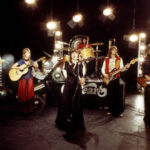The E chord, also known as the E major chord, is a cornerstone for anyone learning guitar. It’s one of the first major chords that beginners typically encounter, and for good reason. Its bright and uplifting sound is fundamental to countless songs across genres like rock, pop, and country. In standard E tuning, the E chord resonates with a cheerful energy, no matter which variation you choose to play.
While there are several ways to form an E chord on the guitar, the essential element remains consistent: you should aim to strum all six strings. This holds true whether you are playing a simplified version or a more complex fingering of the chord.
Let’s start by exploring the standard and most commonly taught version of the E major chord.
Playing the Standard E Major Chord
Once you’re comfortable with basic guitar chords, learning the standard E major chord is a natural progression. This version, utilizing your middle and ring fingers, produces a richer and fuller sounding E chord, often preferred by guitarists.
Here’s how to play this essential chord in the open position:
- Place your index finger on the 1st fret of the G string (3rd string).
- Position your middle finger on the 2nd fret of the A string (5th string).
- Set your ring finger on the 2nd fret of the D string (4th string).
Make sure to strum all six strings from the low E string downwards to achieve the full sound of the chord.
This standard E chord voicing creates a resonant and complete sound, composed of the notes E, B, E, G#, B, and E. It’s a powerful and versatile chord that will quickly become a favorite in your playing.
Songs That Feature the E Chord
The E chord’s versatility is evident in its widespread use across music history. From defining rock anthems to timeless folk melodies, the E chord appears in a vast array of recognizable songs. Below are just a few examples of popular hits that prominently feature the E chord.
Rock Anthems
Rock music is rife with iconic riffs and chord progressions built around the E chord. Two legendary rock songs that immediately come to mind are “(I Can’t Get No) Satisfaction” by The Rolling Stones and “”Rock and Roll All Nite” by Kiss. Both songs powerfully utilize the E chord to create their signature sounds.
Listen carefully to ZZ Top’s hit single, “Legs,” and you’ll hear the E chord driving its distinctive groove. Even in the more psychedelic soundscapes of Tame Impala’s “Feels Like We Only Go Backwards,” the E chord subtly weaves its way into the composition.
For fans of acoustic rock, U2’s iconic track “Desire” incorporates a jangly E chord that adds to its unique sonic texture.
Folk Classics
The E chord also has deep roots in folk music, appearing in some of the oldest songs known. “Greensleeves,” a traditional English folk ballad dating back centuries, prominently features the E chord in its melody.
A more contemporary example in folk music is Fleet Foxes’ beautifully harmonized song “White Winter Hymnal,” where the E chord contributes to its rich, layered sound.
Pop Sensations
Pop music, known for its catchy and upbeat melodies, frequently utilizes the bright sound of the E chord. The Beach Boys’ timeless hit, “Good Vibrations,” is a perfect example, employing a cheerful E chord to enhance its sunny disposition. Moving to modern pop-rock, Coldplay’s popular song “Yellow” also incorporates a fundamental E chord as part of its harmonic structure.
Country Staples
From classic country twang to modern country-pop crossovers, the E chord is a staple in country music. Whether you prefer the traditional sounds of George Strait’s “All My Ex’s Live in Texas” or contemporary styles, you’re likely to hear an E chord within country chord progressions.
Strong female voices in country music have consistently delivered hits featuring the E chord. Patsy Cline’s classic ballad “I Fall to Pieces,” Miranda Lambert’s energetic “Little Red Wagon,” and Reba McEntire’s powerful storytelling in “In the Midnight Hour” all showcase the E chord’s versatility in the genre.
Even songs that blend genres like rock and blues often rely on the E chord. Otis Redding’s “(Sittin’ On) The Dock of the Bay” seamlessly incorporates the E chord into its soulful progression. For a more recent example of this genre fusion, Nathaniel Rateliff and the Night Sweats’ stomping track “S.O.B.” provides a great exercise in playing songs that include the E chord.
The lineage connecting blues and rock is also punctuated by the E chord. Many blues classics, later popularized by rock icons, feature this chord. Examples include Johnny Burnette’s “Train Kept a Rollin’” (famously covered by Aerosmith) and “Hey Joe” by Billy Roberts, which became a signature song for Jimi Hendrix.
For those drawn to traditional blues, Robert Petway’s “Catfish Blues” (also covered by both Hendrix and blues legend Muddy Waters) and Bo Diddley’s iconic “Who Do You Love” both heavily feature the E chord in their bluesy structures.
Mastering the E chord is a rewarding endeavor that unlocks a vast repertoire of songs. Once you have the standard E chord down, a world of musical possibilities opens up. For tips to refine your guitar technique and explore a wide range of songs, consider checking out resources like Fender Play.
To further expand your chord knowledge, explore Fender Play’s comprehensive chord library and discover valuable tips for mastering various chord types.
If you’re ready to embark on a structured guitar learning journey, start your free trial with Fender Play today!


